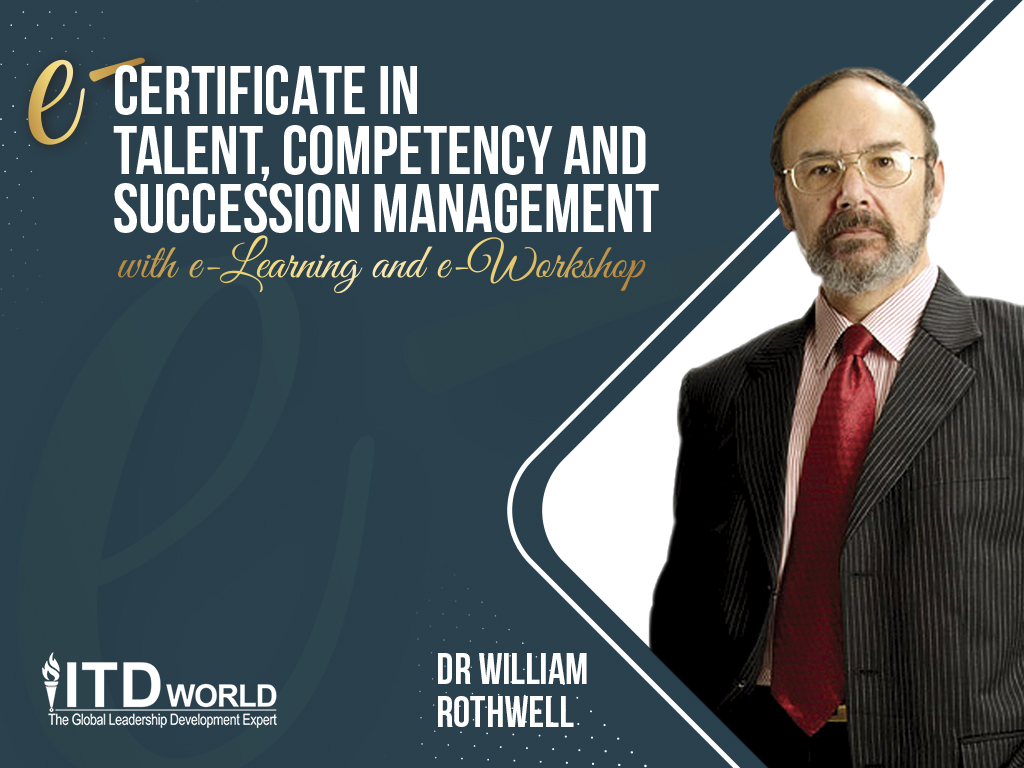Introduction:
Real-world research has proved the fact that a talented employee can be as much as 20 times more productive than the average worker. Just imagine how much more we are capable of achieving with more talent in our organization.
We will focus on key success factors plus the latest practices and developments in the area of talent management, competency modeling, and succession management. Dr. Rothwell will also be sharing with you many contemporary tools and technologies that you will be able to put to practical use right away.
He will bring you to the cutting edge of the profession and enable you to use effective talent, competency, and succession management strategies and tactics to create a competitive advantage for your organization which is sustainable through good and challenging economic times.
Learning Methodology:
– eLearning
Duration: Minimum 35 hours of e-Learning (self-pace).
Course Outline:
Module 1
I. Introduction
• Program purpose
• Program objectives
• Program organization/structure
• Participant objectives
• What do you think? Questions and answers
II. Defining Talent Management and Talent Development, and Making the Business Case for Them
• What are the definitions of talent management and talent development, and why are definitions important?
• How can the business case for continued effort in talent management and succession planning be made to senior leaders during challenging economic times?
• Activity on pinpointing the needs of your organization for talent management and development compared to best practice
• Activity on making the business case for talent management and development
III. Guiding Talent Management and Talent Development Systematically and Strategically
• A model to guide talent management and development
• Step-by-step review of the model
• Questions and answers about the model
Module 2
IV. Using Competency Modeling as Foundations
• What is a competency: Global differences
• Why are competencies important?
• Approaches to management competency modeling
• Activity on management competency modeling
• Approaches to technical competency modeling
• Activity on technical competency modeling
Module 3
V. Using Performance Management and Potential Assessment as Foundations
• What is performance management? (Different definitions exist.)
• Why is performance management important for talent management and development?
• What is potential assessment, and how does it relate to performance management?
• Activity on performance management
• Activity on potential assessment
VI. Recruiting and Selecting Talent
• How does recruiting and selecting talent fit into a comprehensive talent program?
• What is recruiting, and what is selection?
• Why are there needs for innovative approaches to recruitment and selection?
• What research says about the most effective recruiting and selection methods
• Activity on Recruitment
• Debrief of the Activity
• Activity on Selection
• Debrief of the Activity
VII. Using Alternative Sources of Talent
• What are “alternatives” sources of talent?
• Why are they important?
• What role do they play in talent management? Activity on using alternative sources of talent to meet talent needs
• Debrief of the Activity
Module 4
VIII. Developing Individuals through Individual Development Planning
• What is individual development, and how can it be planned based on competencies?
• What approaches exist to individual development?
• How are plans formulated, implemented and evaluated?
• Activity on discovering developmental strategies
• Debrief of the activity
• Unusual thinking about talent management and development: Cutting-edge approaches
IX. Talent Is More than Staffing: Technical Succession Planning to Address Transfer of Knowledge and Institutional Memory
• What is technical succession planning?
• What model guides technical succession planning?
• What practical techniques can be used to transfer knowledge?
• Activity on technical succession planning
• Debrief of the Activity
Module 5
X. Talent Is More than Staffing: Social Relationship Succession Planning to Address the Passing On of Business Contacts and Relationships
• What is social relationship succession planning?
• What model guides social relationship succession planning?
• What practical techniques can be used to transfer professional contacts?
• Activity on social relationship succession planning
• Debrief of the Activity
XI. Retaining Talent
• How does retention fit into a comprehensive talent program?
• Why are there needs for more attention to retention?
• What research says about the most effective retention strategies?
• Activity to compare your organization to best practice in retention
• Activity on retention
XII. Conclusion
• Summary of the program purpose, objectives, and organization
• Final questions and answers
Please click here for more info.

